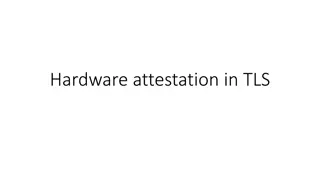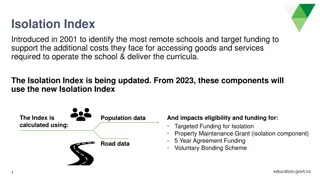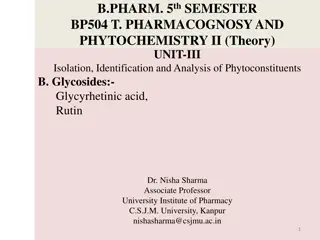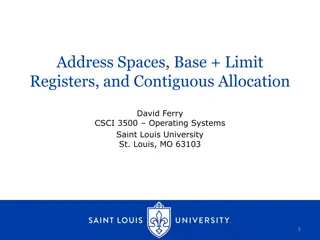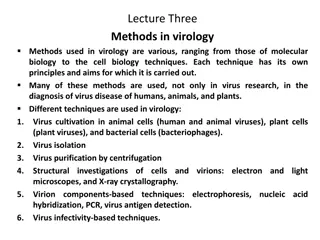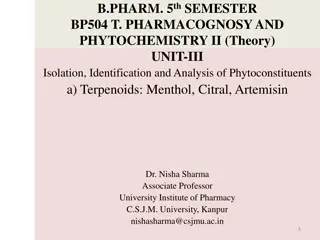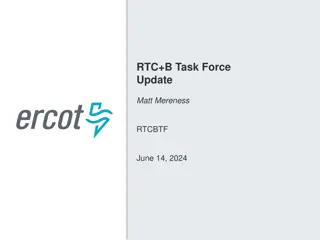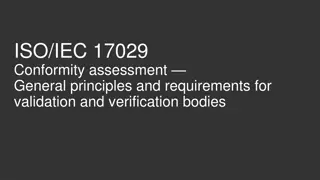Integrity in Attestation and Isolation by Luca Wilke
Explore the significance of integrity in the context of attestation and isolation in cloud computing and trusted execution environments. The research delves into the role of Trusted Execution Environments (TEE), commercial TEEs like ARM Trustzone, Intel SGX, and AMD SEV, potential attacks on SEV's attestation, and the importance of maintaining integrity in security protocols.
Download Presentation

Please find below an Image/Link to download the presentation.
The content on the website is provided AS IS for your information and personal use only. It may not be sold, licensed, or shared on other websites without obtaining consent from the author. Download presentation by click this link. If you encounter any issues during the download, it is possible that the publisher has removed the file from their server.
E N D
Presentation Transcript
The Role of Integrity in Attestation and Isolation Luca Wilke Based on papers SEVurity and undeSErved trust which are joint work with: Jan Wichelmann, Florian Sieck, Mathias Morbitzer and Thomas Eisenbarth Wilke,Wichelmann,Sieck,Eisenbarth, undeSErVed trust: Exploiting Permutation-Agnostic Remote Attestation , WOOT2021 Wilke,Wichelmann,Morbitzer,Eisenbarth, SEVurity: No Security Without Integrity: Breaking Integrity-Free Memory Encryption with Minimal Assumptions.", 2020 IEEE Symposium on Security and Privacy (SP) 1
Cloud Computing & Complex Software Stacks Cloud Computing requires trust in Hypervisor shared resources between guests TEEs can remove trust from Hypervisor Attack Complex Software Stacks large attack surface TEEs allow isolated trust bubbles Attack Attack 2
Trusted Execution Environments TEE Attestation of Content Isolation at Runtime 3
Comercial TEEs ARM Trustzone Intel SGX AMD SEV 4
Attack on SEV s Attestation 5
Loading initial code image Hash State = Hash State = A Hash State = A,B Measurement=HMAC(...,Finalize(Hash State);Key) 7
Loading initial code image Run 1 Run 2 Hash State = A,B Hash State = A,B Hash State = Hash State = Measurement=HMAC(...,Finalize(Hash State);Key) Measurement=HMAC(...,Finalize(Hash State);Key) Different VM content, same measurement! Block granularity is as low as 16 bytes 8
Exploit 9
Example: Breaking a Password Check ...if( suppliedPw != correctPW ) { abort(); } ... Original Code Manipulated Code 10
Bootstrap Encryption/Decryption Oracles 1. Reorder code blocks without changing attestation 2. Malicious Gadget maps VM s stack to an unencrypted page 3. Hypervisor writes ROP addresses and payload code onto VM s stack 4. ROP gadgets moves payload to private page and executes it Blockchain produced by reordering the memory blocks Encryption/Decryption Code Execution 11
Case Study : Stealing Disk Encryption Keys Initialization of VM Scenario SEV only protects RAM; Disk Encryption is done in SW Secure Processor has API to securely load secrets into VM s RAM Protected by Attestation UEFI Attack Protected by Attestation Bootloader Use ROP gadget to move secret from encrypted memory to unencrypted memory Loaded from Encrypted Disk OS 12
Mitigations SEV(-ES): SEV(-SNP) Increase minimal code block size in launch command Include addresses of blocks in measurement Neither can fully fix the problem due to untrusted Nested Page Tables Nested Page Tables problem fixed Attestation protocol has larger block sizes and includes addresses 13
Attack on SEVs Isolation 14
Encryption Mode Old Mode [DYM+] Updated Mode SEVurity Tweaks VM independent Linear function of physical address 15 [DYM+] Z.-H. Du, Z. Ying, Z. Ma, Y. Mai, P. Wang, J. Liu, and J. Fang, Secure encrypted virtualization is unsecure, arXiv preprint arXiv:1712.05090, 2017
Tweaks Tweak constant Zen 1, Zen 1 Embedded Low entropy, static tweaks Reverse engineered Zen 2, (Zen 3?) High entropy tweaks Per boot randomness in tweaks Tweaks unknown Value (16 Byte) t2 82 25 38 38 .... t5 ec 09 9c ec ... ... ... t12 b0 92 30 c2 ... ... ... Tweak(0x1000) = t12 Tweak(0x1010) = t12 t4 16
Exploit Using the guest kernel as a known plaintext source gives us control over 2 bytes Upper limit is 4 bytes, due to tweak periodicity Same exploit strategy as with attestation attack possible Can use blocks more than once Can alter memory layout on the fly Moving ciphertext block changes its plaintext 19
Mitigations Zen 2 CPUs have high entropy tweaks SEV-SNP (Zen 3) prohibits Hypervisor from writing to VM memory 20
Conclusion 21
Summary Reordering 16 byte code blocks allows construction of powerful malicious gadgets Two attack vectors Attestation of SEV(-ES) does not detect permutations Zen 1: XEX Cryptosystem with weak tweaks allows to move code blocks Both attacks mitigated with SEV-SNP (Zen 3) @lucawilkeUzL @JanWichelmann @tomcrypt @Florian_UzL_ITS uzl-its.github.io/undeserved-trust/ uzl-its.github.io/SEVurity/ 22
SEV Scenario 24
SEV Scenario 25
SEV Scenario 26
Bootstrap Encryption/Decryption Oracles Read/Write Arbitrary Data Execute Arbitrary Code Case Study: Steal Disk Encryption Keys Blockchain produced by reordering the memory blocks 27
Exploit Same exploits as with attestation attack possible Even more control, as we can use blocks more than once rewrite injected code on the fly 28
Case Study : Stealing Disk Encryption Keys Initialization of VM Scenario SEV only protects RAM; Disk Encryption is done in SW Secure Processor has API to securely load secrets into VM s RAM Protected by Attestation UEFI Attack Protected by Attestation Bootloader Use ROP gadget to move secret from encrypted memory to unencrypted memory Protected by Disk Encryption OS 29
Creating SEV VMs : Boot Sequence vCPU jumps to Reset Vector configures CPU Initialization of VM UEFI Bootloader OS 30
Countermeasures SEV(-ES) Increase minimal size limit for measured blocks during launch Makes exploitation harder Limited to 4096 byte blocks (one page) due to page remapping flaw Include addresses of blocks in measurement Can ensure order inside a page but not beyond due to page remapping flaw SEV(-SNP) Page remapping flaw is resolved Block size is increased to 4096 bytes (page) Addresses included in measurement 31
Responsible Disclosure Disclosed to AMD on January 19th, 2021 Embargo until May 11, 2021 Mitigation with SEV-SNP on 3rd Gen EPYC CVE-2021-26311 32
Exploiting Control Over Blocks v1 1. Reorder initial VM image to create a malicious code gadget 2. Measure and start VM, Owner cannot detect malicious gadget Problems: Does not scale well Block availability might vary Blockchain produced by reordering the memory blocks 33
Exploiting Control Over Blocks v2 1. Reorder initial VM image to create a malicious code gadget 2. Measure and start VM, Owner cannot detect malicious gadget 3. Malicious Gadget maps some VM page as unencrypted and jumps to it 4. Hypervisor fills page with attack code before jump Does not work: Code fetch always considers page as encrypted Blockchain produced by reordering the memory blocks 34
Case Study : Stealing Disk Encryption Keys Scenario SEV only protects RAM; Disk Encryption is done in SW Secure Processor has API to securely load secrets in VM RAM Attack Use ROP gadget to move secret from encrypted memory to unencrypted memory 35
ROADMAP - - Understand flaw in SEV (-ES) attestation Exploit-Chain for Arbitrary Code execution 36
Creating SEV VMs : Launch Secrets Derive two keys, TEK and TIK, via DH Key-Exchange. HMAC is keyed with TIK -> Guest Owner can verify Guest Owner encrypts+Integrity protects Secret Data with TIK and TEK Secure Processor stores Secrets in VM RAM 37


